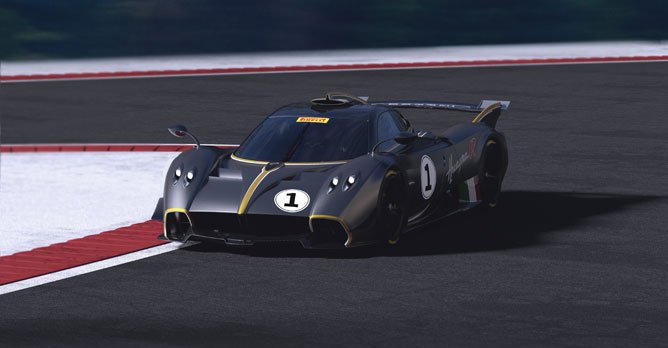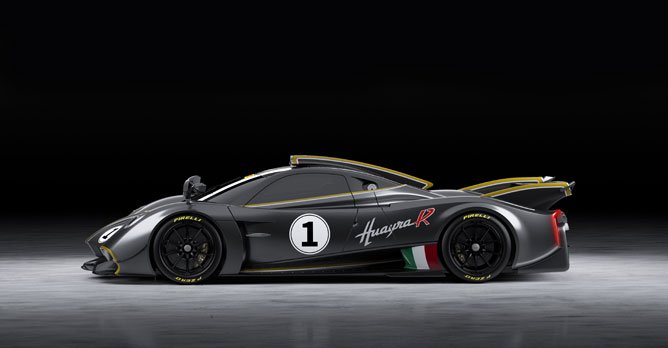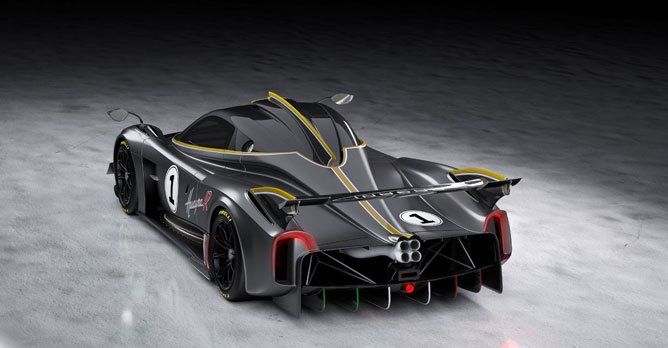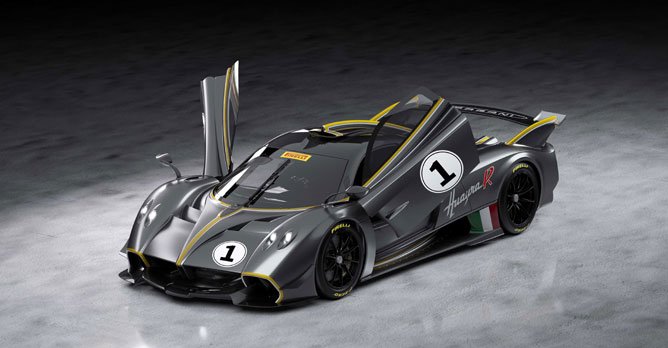The Pagani Huayra R, Pagani's latest track-only naturally aspirated special
11 Apr 2021|1,747 views
The Huayra R, the new track-focused hypercar from Pagani, combines the highest level of automotive engineering and aerodynamic know-how with unprecedented aesthetic sensitivity in an exercise of style that represents the full expression of Pagani's technological development.
The Zonda R, created with cutting-edge materials derived from the aerospace industry and Formula One, was presented at the Geneva Motor Show in 2009 where it embodied the pinnacle of Pagani's technological development, combined with unprecedented attention to aesthetics for a track car.
Offering a driving experience and performance simply impossible on the road, the Zonda R demonstrated its full potential, attaining major milestones on the world's most prestigious circuits, including a blistering time of six minutes and 47 seconds at the Nurburgring, and was celebrated on many covers of the main magazines of that time.
The Huayra R is a car packed with innovative solutions developed to achieve maximum performance. The project was not based on any production model, which allowed development targets for each individual component to be raised significantly, forcing engineers to tackle a number of technical challenges. Firstly, the development of the most powerful, naturally aspirated internal combustion engine in Pagani's history.
The Pagani V12-R - the beating heart of the Huayra R - is a 12-cylinder, 6.0-litre, naturally aspirated racing engine, designed from the ground up in partnership with HWA AG specifically to meet Pagani's need to equip its new creation with the lightest, most powerful and efficient track-ready V12 ever created. The new engine delivers 838bhp and 750Nm, screams up to the redline at 9,000rpm, and only weighs 198kg.
Attached to the central monocoque, with which it forms a structural element capable of supporting the transmission system and the chrome-molybdenum alloy steel subframes, the new engine is exceptionally efficient and easy to run, with service cycles only every 10,000 km.

Securely attached to the monocoque as well as the engine, contributing to the overall rigidity of the chassis and withstanding heavy dynamic loads, the complete transmission system is designed to integrate structurally with the entire suspension unit through dedicated attachment points in order to maximise the architectural efficiency of the car.
The new exhaust system developed specifically for the Huayra R guarantees rapid and effective evacuation of exhaust gases. Made from Inconel alloy and coated in ceramic to aid in heat dissipation, the entire exhaust system is not only extremely lightweight construction, it also provides the Huayra R with an unprecedented acoustic experience.
The soundtrack of the Huayra R is indeed pure emotion, thanks to the unique design of the manifolds and tailpipes, with identical length exhaust pipes for all twelve cylinders allowing the V12-R to howl like a Formula One car of days past.

Manufactured using a carbon fibre-titanium composite, the new monocoque incorporates the seats fully, guaranteeing maximum protection together with specific shock-absorption side structures and the roll-bar, while maintaining easy access to the cockpit.
The front frames benefit from the development experience and crash tests carried out to fine-tune the Huayra project, while also being designed specifically for the track. The rear frame, in conjunction with the powertrain unit, forms an integrated structure with the monocoque, helping to maximise the mechanical properties of the chassis.
The combination of new structural principles and materials specially developed for the Huayra R design, together with the resulting enhancement of the mechanical properties of the structure, means that it tips the scales at a dry weight of 1,050 kg.

Contributing to reliable performance of the car, there are two new side air intakes at the front to ensure maximum cooling efficiency for the front wheel braking system, as well as channelling the outgoing airflow towards the side of the car, minimising turbulence and helping to generate maximum downforce.
Ensuring adequate cooling of the powerful engine required relentless work on the radiator and internal fluid dynamics, while new wing profiles were introduced on the front bonnet to improve air extraction speed and create greater stability at the front. New air vents above the wheel arch and the generous side outlet allow even more effective channelling of air to flow to the rear aerodynamic appendages.
The new roof scoop, with its integrated centre fin, guarantees maximum intake efficiency for the Pagani V12-R. The flat bottom, in combination with the rear diffuser and the distinctive wing, helps to generate maximum downforce.

The Huayra R is fitted with Brembo CCM-R carbon-ceramic discs coupled with racing pads. The brakes, with six-piston calipers, all around clamping on 410mm discs in front and 390mm discs in the rear, have significant advantages in terms of thermal conductivity and maximum braking power, allowing for greater rigidity and lower operating temperatures in extreme track use while helping to extend the life cycle of the system.
As for the tyres, Pirelli P Zero slick tyres are fitted on all four corners, with 275mm-wide tyres up front and 325mm-wide tyres in the rear, together with dry and wet compounds available for different weather conditions. The tyres wrap around lightweight 19-inch rims made by APP Tech and are forged from aluminium alloy.
Inside the Huayra R, all essential controls, such as traction control, ABS map selection, radio communication and other important functions are immediately available on the quick-release, height and length adjustable steering wheel, which can be pulled out for easy access to the cockpit. The gearshift paddles are mounted at the rear of the steering wheel.
Secondary controls such as lights, engine maps, suspension maps and brake balance selector are available on the centre console. A high resolution and fully customisable motorsport dashboard display feeds the driver with the necessary information. The onboard telemetry logs all vehicle data, enabling the driver and pit crew to analyse performance, find the perfect vehicle settings for any given track, and monitor the vehicle.
The Huayra R, the new track-focused hypercar from Pagani, combines the highest level of automotive engineering and aerodynamic know-how with unprecedented aesthetic sensitivity in an exercise of style that represents the full expression of Pagani's technological development.
The Zonda R, created with cutting-edge materials derived from the aerospace industry and Formula One, was presented at the Geneva Motor Show in 2009 where it embodied the pinnacle of Pagani's technological development, combined with unprecedented attention to aesthetics for a track car.
Offering a driving experience and performance simply impossible on the road, the Zonda R demonstrated its full potential, attaining major milestones on the world's most prestigious circuits, including a blistering time of six minutes and 47 seconds at the Nurburgring, and was celebrated on many covers of the main magazines of that time.
The Huayra R is a car packed with innovative solutions developed to achieve maximum performance. The project was not based on any production model, which allowed development targets for each individual component to be raised significantly, forcing engineers to tackle a number of technical challenges. Firstly, the development of the most powerful, naturally aspirated internal combustion engine in Pagani's history.
The Pagani V12-R - the beating heart of the Huayra R - is a 12-cylinder, 6.0-litre, naturally aspirated racing engine, designed from the ground up in partnership with HWA AG specifically to meet Pagani's need to equip its new creation with the lightest, most powerful and efficient track-ready V12 ever created. The new engine delivers 838bhp and 750Nm, screams up to the redline at 9,000rpm, and only weighs 198kg.
Attached to the central monocoque, with which it forms a structural element capable of supporting the transmission system and the chrome-molybdenum alloy steel subframes, the new engine is exceptionally efficient and easy to run, with service cycles only every 10,000 km.

Securely attached to the monocoque as well as the engine, contributing to the overall rigidity of the chassis and withstanding heavy dynamic loads, the complete transmission system is designed to integrate structurally with the entire suspension unit through dedicated attachment points in order to maximise the architectural efficiency of the car.
The new exhaust system developed specifically for the Huayra R guarantees rapid and effective evacuation of exhaust gases. Made from Inconel alloy and coated in ceramic to aid in heat dissipation, the entire exhaust system is not only extremely lightweight construction, it also provides the Huayra R with an unprecedented acoustic experience.
The soundtrack of the Huayra R is indeed pure emotion, thanks to the unique design of the manifolds and tailpipes, with identical length exhaust pipes for all twelve cylinders allowing the V12-R to howl like a Formula One car of days past.

Manufactured using a carbon fibre-titanium composite, the new monocoque incorporates the seats fully, guaranteeing maximum protection together with specific shock-absorption side structures and the roll-bar, while maintaining easy access to the cockpit.
The front frames benefit from the development experience and crash tests carried out to fine-tune the Huayra project, while also being designed specifically for the track. The rear frame, in conjunction with the powertrain unit, forms an integrated structure with the monocoque, helping to maximise the mechanical properties of the chassis.
The combination of new structural principles and materials specially developed for the Huayra R design, together with the resulting enhancement of the mechanical properties of the structure, means that it tips the scales at a dry weight of 1,050 kg.

Contributing to reliable performance of the car, there are two new side air intakes at the front to ensure maximum cooling efficiency for the front wheel braking system, as well as channelling the outgoing airflow towards the side of the car, minimising turbulence and helping to generate maximum downforce.
Ensuring adequate cooling of the powerful engine required relentless work on the radiator and internal fluid dynamics, while new wing profiles were introduced on the front bonnet to improve air extraction speed and create greater stability at the front. New air vents above the wheel arch and the generous side outlet allow even more effective channelling of air to flow to the rear aerodynamic appendages.
The new roof scoop, with its integrated centre fin, guarantees maximum intake efficiency for the Pagani V12-R. The flat bottom, in combination with the rear diffuser and the distinctive wing, helps to generate maximum downforce.

The Huayra R is fitted with Brembo CCM-R carbon-ceramic discs coupled with racing pads. The brakes, with six-piston calipers, all around clamping on 410mm discs in front and 390mm discs in the rear, have significant advantages in terms of thermal conductivity and maximum braking power, allowing for greater rigidity and lower operating temperatures in extreme track use while helping to extend the life cycle of the system.
As for the tyres, Pirelli P Zero slick tyres are fitted on all four corners, with 275mm-wide tyres up front and 325mm-wide tyres in the rear, together with dry and wet compounds available for different weather conditions. The tyres wrap around lightweight 19-inch rims made by APP Tech and are forged from aluminium alloy.
Inside the Huayra R, all essential controls, such as traction control, ABS map selection, radio communication and other important functions are immediately available on the quick-release, height and length adjustable steering wheel, which can be pulled out for easy access to the cockpit. The gearshift paddles are mounted at the rear of the steering wheel.
Secondary controls such as lights, engine maps, suspension maps and brake balance selector are available on the centre console. A high resolution and fully customisable motorsport dashboard display feeds the driver with the necessary information. The onboard telemetry logs all vehicle data, enabling the driver and pit crew to analyse performance, find the perfect vehicle settings for any given track, and monitor the vehicle.
Latest COE Prices
December 2025 | 1st BIDDING
NEXT TENDER: 17 Dec 2025
CAT A$105,413
CAT B$123,900
CAT C$76,501
CAT E$123,000
View Full Results Thank You For Your Subscription.



























